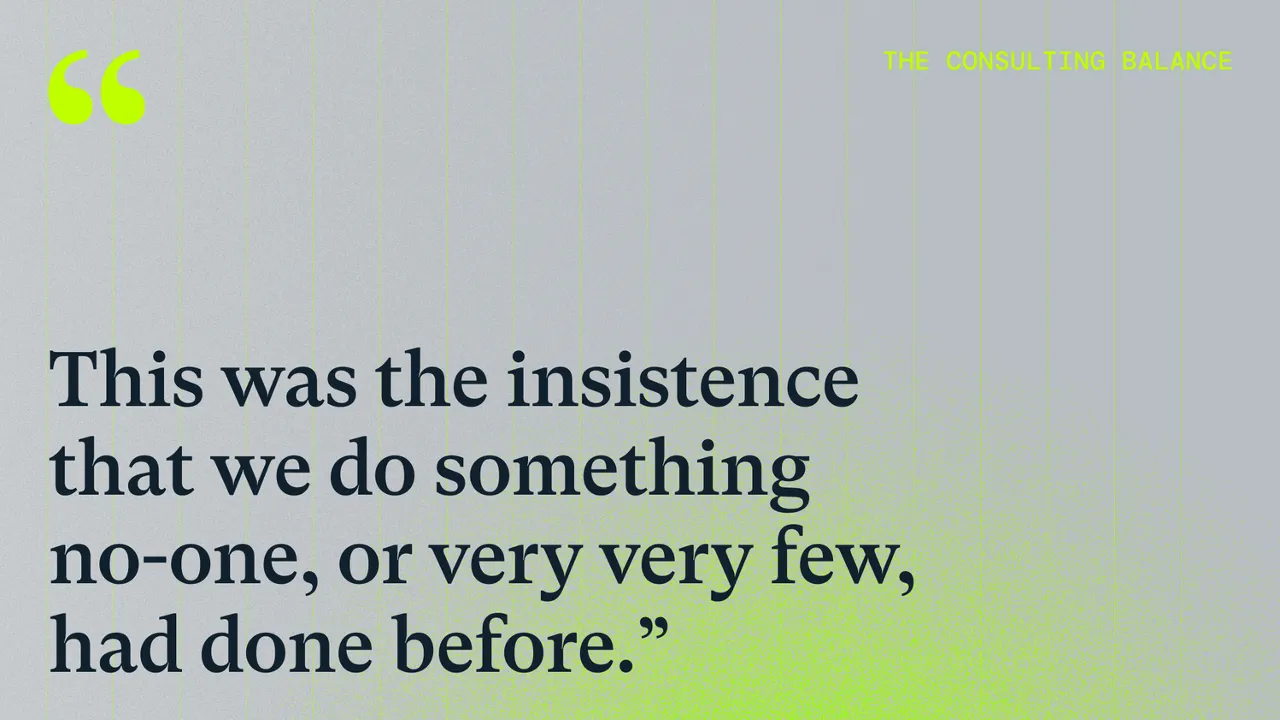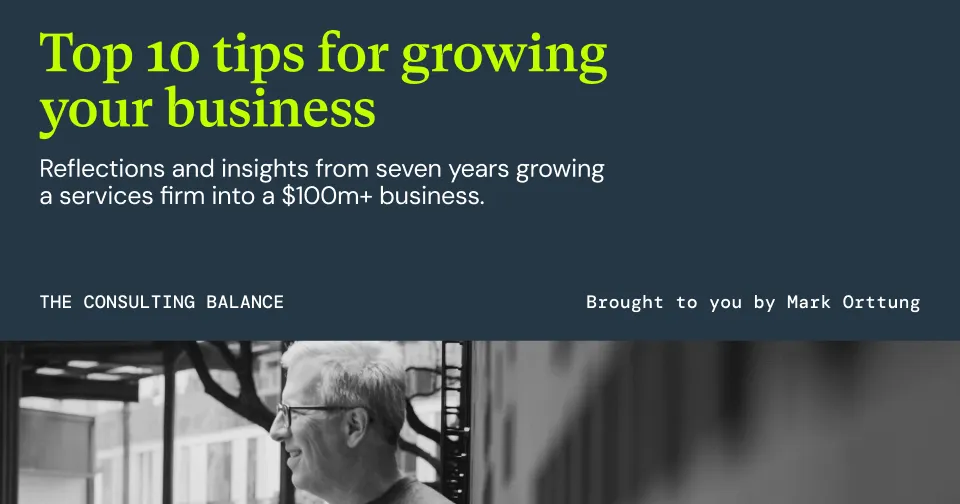How to grow your business using the “Three Arc” model
.avif)
Mark and Allen share how they used a simple concept to reinvent Nexient for even greater success.
By late 2019 we had come a long way from when I first joined Nexient. It wasn’t even called Nexient when I started, and rebranding from “Systems In Motion” was one of my first challenges. Five years on from this and Nexient was really standing out and growing in revenue. In that time we had:
- changed our name and positioning strategy;
- moved to a product-centric approach;
- built our own consulting practice;
- introduced a GM-structured model; and
- nailed our mission statement to become a rallying cry for the company at large.
All of this was helping us scale to beyond $100m in revenue. But that need to reinvent ourselves every two to three years was still quite ad hoc. We required a model or process to formalize this for us.
In previous articles I have introduced Allen Debes who was integral to Nexient’s growth and success. Allen led our Central region into becoming our fastest growing, and was key to implementing our GM structured model to scale the company to beyond $100m. And he’d only started in January that year!
Allen had a passion for looking at the strategic direction of the company and formalizing how we’d evolve it over time. So when he introduced our leadership team to the “Three Arc” model and how we could use it to map our evolution, we were all ears.
How Allen developed the Three Arc model
Mark and I, along with others on the executive team, had something in common - we had all begun our careers at Accenture. We agreed that having this as our foundation had contributed significantly to our career success. We were very grateful for those experiences serving clients and being part of a culture of consulting excellence in the 1990s.
While working at Accenture, and observing other elite consultancies from afar, I noticed a fairly basic pattern from a go-to-market (GTM) perspective. In order to meet complex market forces impacting their clients, there’s a constant effort for reinvention, or at the very least the need to announce to the market where their services are heading. For example, in the 1990s the best consultancies were shifting into helping clients with Enterprise Resource Planning (ERP) - overhauling clients' internal processes onto a single ERP platform to run their business. This did not mean the best consultancies abandoned any of their other service lines but the “outer arc” of the services provided at scale were focused on ERP strategy and implementation.
Which begs the question, what was the “inner arc”? These were the core and differentiated service lines which were typically offered at scale. They would be charged at lower billable rates and margins because competition had caught up and leveled the playing field. In these areas the market was becoming increasingly competitive and crowded due to GSIs, scaling boutiques and lifestyle services businesses.
Years later in the 2010s, I was the VP of Client Delivery for Magnet 360 for several years. I helped our team build a scaling boutique services business focused on CRM, specifically Salesforce which was scaling rapidly in the market at the time. In 2014 during a discussion with our CEO and COO (also from Accenture), I impulsively went to the whiteboard and drew three simple arcs. I was attempting to make the case for us to evolve beyond our core and differentiated services and predict where our clients would be in the future. It led to a great discussion and some directional experimentation in Configure, Price Quote (CPQ) and customer service management (CSM).
Bringing the arcs to Nexient
Fast-forward to late 2019 and early 2020 at Nexient with Mark and the rest of our emerging world class team. By then we knew we were very strong in the market as a proven scaling boutique. We were providing exceptional custom software engineering teams to our enterprise clients from our domestic delivery center in Ann Arbor, Michigan. Arguably this had become a “core” or “innermost arc” service for clients.
With Andy Lin and Jenna Chamra joining in 2017 before my arrival, we had also added what this simple model would characterize as “differentiated” or “middle arc” services. These focused on up-front custom software design, helping clients more effectively design persona-driven experiences that could then be built by our domestic engineering teams using agile delivery methods.
Without actually calling them “arcs” it was clear to me that Nexient had the innermost and middle ones in place - US-based custom software engineering (core/inner) + up-front custom software design (differentiated/middle).
.webp)
A third arc was needed
The team, led by Mark, Andy and I, still had a strong sense that these two components would not be enough to fully serve our clients. Our common backgrounds drove our desire to generate industry-leading growth for Nexient. To do this we knew we also needed to evolve our services for our consultants and engineers. These were some clever, sought-after people working for us, so we had to give them the most meaningful work possible in a competitive employment market. So drawing on his software product background, Mark added the notion of a “new category” requirement to the arc model. This was the insistence that we do something no-one, or very very few, had done before.
How to conduct research using the Three Cs
Without realizing, we instinctively began using the “Three Cs” construct to conduct some research. (This is often noted as having been created by Kenichi Ohmae, a Japanese business strategist.)
- We quickly evaluated our Client’s current and plausible future needs;
- We took a scan of our Competitors in the market; and
- We got very honest with ourselves about our own Company.
Through that process we built relationships with leading analysts such as Gartner and Forrester, which gave us insights into the custom software services market. We discovered that the addressable market was massive and would continue to be so for years to come (to the tune of $40 billion, growing 8-12% per year). This affirmed that staying focused in custom software development for our clients had plenty of room for market growth.

How we found our third arc
So, with our agile domestic engineering core strength, and our emerging differentiation in persona-driven design in place, what else could we do to grow our market share? Mark wisely assembled a slightly broader team, a strategy committee of sorts, and each member took an assignment to evaluate subsets of potential market extension (DevOps, data & analytics, headless commerce, and more).
Three things seemed to matter most in our decision:
- Focus is one of those “everythings” in business and life, and standing out in a crowded market would require that we remained focused to avoid “me too” issues.
- Mark was guiding us towards a new category generally unexplored by competitors, otherwise known as an unsolved problem for our clients.
- Our enterprise clients were hiring and/or promoting a buyer persona we were already serving: intrapreneurial agitators intent on helping their company compete digitally against software product companies (mostly out of Silicon Valley).
What we discovered
This led to an “outer arc” - category creating - or, offering to provide “product consulting” and “full product teams” to our clients to help the buyer persona accelerate adoption of a “product mindset” in the enterprise, and more actively move away from a “project mindset.” One of the best things about this decision was that our most progressive buyers and prospective buyers immediately “got it” which reduced the need to educate the market the way other new category offerings can sometimes require. This threw gas on the fire just in time to continue our growth and avoid the plateau that can come from market saturation and lack of relevance.
%25252B(1).webp)
It is also worth mentioning here a basic emerging tenet of the “Three Arc” model. The best GTM approaches can feed long-tail revenue to the core service and provide more and more full value to clients over many years.
Top 5 Tips to growing your business using the “Three Arc” model
- It’s quite likely your business inherently has arcs within it. Do a deep dive into your company and the services it provides.
- Take a good look at your market and what your clients need that nobody does.
- Identify your core offering - what is it that you provide at scale? This is your inner arc.
- Do you have a differentiated offering? What do you provide that your competitors don’t? This is your middle arc.
- Work hard to find a focused third arc. This is your category creating outer arc. If implemented correctly this is what will make you shine above your competitors and encourage prospective buyers to tap into every area of your business.

.webp)

.webp)
